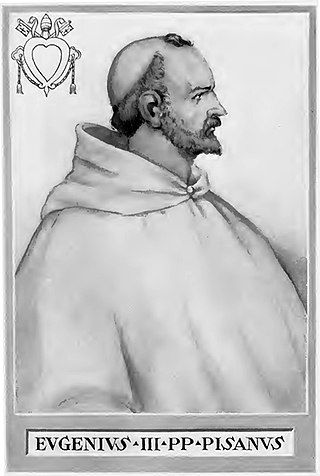
Year 1135 (MCXXXV) was a common year starting on Tuesday of the Julian calendar.
The 1140s was a decade of the Julian Calendar which began on January 1, 1140, and ended on December 31, 1149.

Year 1145 (MCXLV) was a common year starting on Monday of the Julian calendar.

Bohemond II was Prince of Taranto from 1111 to 1128 and Prince of Antioch from 1111/1119 to 1130. He was the son of Bohemond I, who in 1108 was forced to submit to the authority of the Byzantine Empire in the Treaty of Devol. Three years later, the infant Bohemond inherited the Principality of Taranto under the guardianship of his mother, Constance of France. The Principality of Antioch was administered by his father's nephew, Tancred, until 1111. Tancred's cousin, Roger of Salerno, managed the principality from 1111 to 1119. After Roger died in the Battle of the Field of Blood, Baldwin II of Jerusalem took over the administration of Antioch. However, he did acknowledge Bohemond's right to personally rule the principality upon reaching the age of majority.

The Zengiddynasty was a Muslim dynasty of Oghuz Turkic origin, which ruled parts of the Levant and Upper Mesopotamia on behalf of the Seljuk Empire and eventually seized control of Egypt in 1169. In 1174 the Zengid state extended from Tripoli to Hamadan and from Yemen to Sivas. The dynasty was founded by Imad ad-Din Zengi.

Imad al-Din Zengi, also romanized as Zangi, Zengui, Zenki, and Zanki, was a Turkmen atabeg, who ruled Mosul, Aleppo, Hama, and, later, Edessa. He was the namesake of the Zengid dynasty.

Nūr al-Dīn Maḥmūd Zengī, commonly known as Nur ad-Din, was a member of the Zengid dynasty, which ruled the Syrian province (Shām) of the Seljuk Empire. He reigned from 1146 to 1174. He is regarded as an important figure of the Second Crusade.

Pons was count of Tripoli from 1112 to 1137. He was a minor when his father, Bertrand, died in 1112. He swore fealty to the Byzantine Emperor Alexios I Komnenos in the presence of a Byzantine embassy. His advisors sent him to Antioch to be educated in the court of Tancred of Antioch, ending the hostilities between the two crusader states. Tancred granted four important fortresses to Pons in the Principality of Antioch. Since Pons held his inherited lands in fief of the kings of Jerusalem, Tancred's grant strengthened the autonomy of the County of Tripoli. On his deathbed, Tancred also arranged the marriage of his wife, Cecile of France, to Pons.
Constance of Hauteville (1128–1163) was the ruling Princess of Antioch from 1130 to 1163. She was the only child of Bohemond II of Antioch by his wife, Alice of Jerusalem. Constance succeeded her father at the age of two, after he fell in battle, although his cousin Roger II of Sicily laid claim to Antioch. Her mother assumed the regency, but the Antiochene noblemen replaced her with her father, Baldwin II of Jerusalem. After he died in 1131, Alice again tried to take control of the government, but the Antiochene barons acknowledged the right of her brother-in-law Fulk of Anjou to rule as regent for Constance.
Mu'in ad-Din Unur al-Atabeki was a Turkman ruler of Damascus in the mid-12th century.

Shaizar or Shayzar is a town in northern Syria, administratively part of the Hama Governorate, located northwest of Hama. Nearby localities include, Mahardah, Tremseh, Kafr Hud, Khunayzir and Halfaya. According to the Syria Central Bureau of Statistics (CBS), Shaizar had a population of 5,953 in the 2004 census.
The Complete History, is a classic Islamic history book written by Ali ibn al-Athir. Composed in ca. 1231AD/628AH, it is one of the most important Islamic historical works. Ibn al-Athir was a contemporary and member of the retinue of Saladin, the Kurdish general who captured Jerusalem from the Crusaders and massively reduced European holdings in the Levant, leaving the Principality of Antioch and County of Tripoli much reduced and only a few cities on the coast to the Kingdom of Jerusalem.
The Crusades were a series of religious wars initiated, supported, and sometimes directed by the Latin Church in the medieval period. The best known of these military expeditions are those to the Holy Land in the period between 1095 and 1291 that were intended to conquer Jerusalem and its surrounding area from Muslim rule. Beginning with the First Crusade, which resulted in the conquest of Jerusalem in 1099, dozens of military campaigns were organised, providing a focal point of European history for centuries. Crusading declined rapidly after the 15th century.
Qutb al-Din Mawdud was the Zengid Emir of Mosul from 1149 to 1169. He was the son of Imad al-Din Zengi and brother and successor of Sayf al-Din Ghazi I.
Ma'arrat Misrin is a small city in northwestern Syria, administratively part of Idlib Governorate. Ma'arrat Misrin lies an elevation of 338 metres (1,109 ft). It is located 50 kilometers southwest of Aleppo and 40 kilometers north of Ma'arrat al-Numan and 12 kilometers from Sarmin. Nearby localities include Kafr Yahmul to the north, Zardana and Maarrat al-Ikhwan to the northeast, Taftanaz to the east, Ta'um, Binnish, al-Fu'ah and Kafriya to the southeast, Idlib to the south, and Hafasraja to the southwest.
The military history of the Crusader states begins with the formation of the County of Edessa in 1097 and ends with the loss of Ruad in 1302, the last Christian stronghold in the Holy Land.
Atarib, also known as Atharib or Athareb, is a town in western Aleppo countryside, Aleppo Governorate, Syria. Located 25 kilometres west of the city of Aleppo and 25 km (16 mi) southeast of Reyhanlı in Turkish-administered Hatay Province, it is the regional center of Atarib District. In the 2004 census, the town of Atarib had a population of 10,657.
Kafartab was a town and fortress in northwestern Syria that existed during the medieval period between the fortress cities of Maarat al-Numan in the north and Shaizar to the south. It was situated along the southeastern slopes of Jabal al-Zawiya. According to French geographer Robert Boulanger, writing in the early 1940s, Kafartab was "an abandoned ancient site" located 2.5 mi (4.0 km) northwest of Khan Shaykhun.
The Battle of al-Atharib occurred in 1130 when Imad al-Din Zengi laid siege to al-Atharib in spring and defeated an army led against him to relieve the town commanded by King Baldwin.
The Battle of Qinnasrin was a battle between the Zengids and the County of Tripoli following a successful campaign against Antioch led by Imad al-Din Zengi.







